

Original Article - Year 2014 - Volume 29 -
Program for theoretical and practical training in suture techniques for medical students in the field of plastic surgery at the Federal University of Ceará (UFC)
Sistematização do treinamento teórico e prático de técnicas em suturas para acadêmicos de medicina da disciplina de cirurgia plástica da Universidade Federal do Ceará - UFC
ABSTRACT
INTRODUCTION: Learning suture techniques is a major pillar in the development of a general practitioner. However, training in these skills is often limited during undergraduate medical education.
METHOD: The League and the Plastic Surgery and Reconstructive Microsurgery Service offer a 20-hour course in Theoretical and Practical Suturing for medical students, using ox tongues for training. This study describes the approach to a theoretical and practical basis for suture procedures, and the resulting application by the participants.
RESULT: Students in the eighth session of the suturing course were evaluated through questionnaires, yielding good information on issues such as motivation and comprehension, theoretical-practical relationships, and others.
CONCLUSION: This suture course model was an important tool in academic education, and met the desired goals.
Keywords: Sutures; Training model; Surgical technique; Plastic surgery.
RESUMO
INTRODUÇÃO: O aprendizado de técnicas de sutura é um pilar importante na atuação do médico generalista, porém, muitas vezes o treinamento desses é limitado durante a graduação de medicina.
MÉTODO: Através do Curso Teórico-Prático de Suturas, oferecido pela Liga e pelo Serviço de Cirurgia Plástica e Microcirurgia Reconstrutiva, são realizadas atividades teóricas-práticas com carga horária de 20 horas utilizando línguas de boi para treinamento de estudantes de medicina. Tem-se o objetivo neste trabalho de apresentar a rotina utilizada para fornecer embasamento teórico-prático na realização de procedimentos de sutura, como também os resultados obtidos que demonstram o aproveitamento do curso por parte de seus participantes.
RESULTADO: Os alunos da 8ºedição do curso de suturas foram avaliados através de questionários, obtendo conceito muito bom em quesitos como motivação e compreensão das aulas, relação teórico-prática e outros.
CONCLUSÃO: O modelo deste curso de sutura mostrou-se como uma importante ferramenta na formação acadêmica, cumprindo os objetivos propostos.
Palavras-chave: Suturas; Modelo de treinamento; Técnica cirúrgica; Cirurgia plástica.
Suturing is extremely relevant to daily medical practice. However, most students do not develop basic or satisfactory surgical skills during academic training1-5. Thus, it is essential to include training in minor surgical procedures in standard medical education.
Training based only on theoretical lectures does not achieve the necessary level of skills required for surgical practice6, 7. and must therefore be accompanied by practical classes. However, learning on patients conflicts with moral, ethical, and legal strictures8. The Theoretical and Practical Suturing Course (STPC) offers an organized, ongoing approach to the topic, training medical students in techniques that are often addressed superficially before graduation.
The course is offered to medical students in any class who want to improve and learn about various suturing methods and their application. To date, 480 students participated in eight sessions over three years.
OBJETICTIVE
This study is designed to introduce the STPC program conducted by the League of Plastic Surgery (LPS) of the Plastic Surgery and Reconstructive Microsurgery Service of the Federal University of Ceará. This course is intended to provide the technical basis for correct use of suturing devices and complement surgical training of the medical student. It also offers theoretical education with an emphasis on suturing, and supervised training by monitors using experimental animal parts, thus creating an effective option for undergraduates.
METHOD
The suturing course comprises 16 classes, totaling 20h over a two-week period (Figure 1).
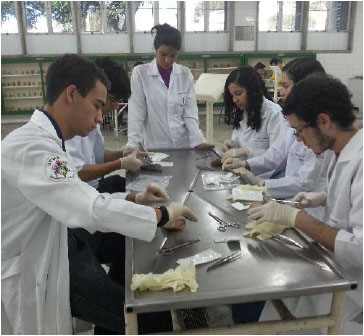
Figure 1. Practical activity performed during STPC.
There are introductory classes providing a theoretical basis for the students. Lectures on surgical instrument technique are presented first, as well as choice of yarn, knot, and suture, workup in many types of injury, and scar development.
Theoretical and practical lectures follow, closely related to learning the various techniques used in the course. The characteristics of each knot and suture are considered, including their application, and advantages and disadvantages. For practical training, students are divided into seven groups under the supervision of a monitor, with classes on each technique using an animal model (ox tongue). There is also practice with local anesthesia and excision of skin lesions (Chart 1).
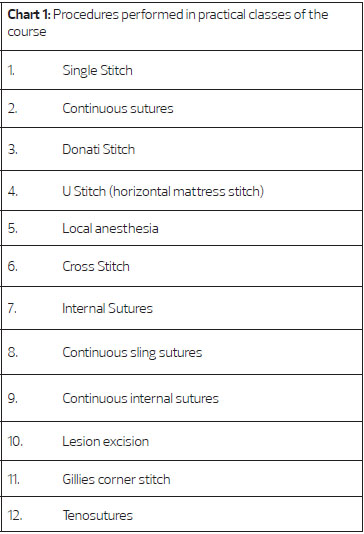
A device was built specifically for practice in tenorrhaphy, combining the properties of the tissue to be reconstructed and the elasticity of the tendon. The animal material used for the course consists of a flexor tendon dissected from pig feet used for other suturing, thereby increasing the similarity of this method with reality (Figure 2).
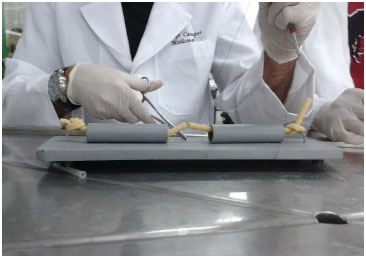
Figure 2. Training activity in tenorrhaphy.
Each participant is provided with a kit containing the materials needed for the proposed technique. These include pairs of latex gloves, nylon 3.0 suture, a Mayo-Hegar needle holder, rat tooth forceps, suture scissors and a number 3 scalpel (Figure 3). The model used to simulate suturing is made of animal parts (ox tongue) (Figure 4).
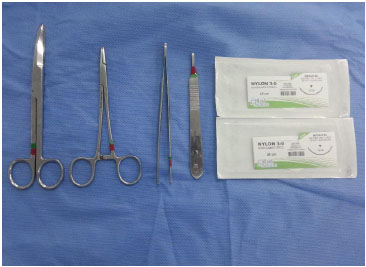
Figure 3. Surgical instruments provided to the students.
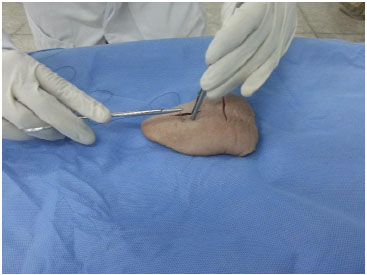
Figure 4. Single stitch in the model used (ox tongue).
To evaluate the quality of the proposed activities, we gave questionnaires to a sample of 40 participants from the course held in June 2013. They were asked to rate different activities between 0 and 10, with qualities assigned to these values (0-2.0 = Very Poor, 2.1-4.0 = Poor, 4.1-6.0 = Average, 6.1-8.0 = Good, 8.1-10 = Very Good) (Chart 2).
RESULTS
Each participant of the eighth session of the STPC received a qualitative questionnaire evaluating key points related to the course activities. (Figure 1)
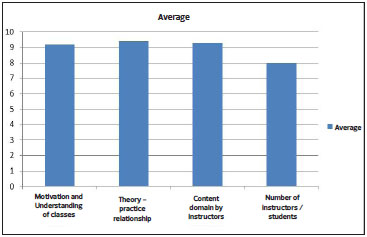
Figure 5. Means obtained after qualitative assessment of ongoing activities.
The average rating score for motivation and understanding was 9.2, or Very Good.
When asked whether the explanations made during the practical part were instructive in relation to theory, the mean response was 9.4 (Very Good). When the monitors were evaluated for mastery of content and technique presented, the average was 9.3 (Very Good).
When evaluating the relative number of instructors to students, the average was 8.0.
When asked about confidence to enter an internship, which requires the knowledge presented, 100% answered yes, demonstrating the importance of this activity.
DISCUSSION
There are many models for training in suturing in the literature. Often these utilize skin substitutes (pigskin, chicken skin9, or ethylene-vinyl acetate). However, these models are inadequate for practicing some types of cutaneous suturing due to differences from human skin4. Cadavers are useful in surgical training, both for learning the anatomy for a surgical procedure, as well as in the training of several techniques that are limited in animal models10. However, this requires partnership with forensic institutes, an unavailable option because of the number of students participating in the course.
The Guidelines and Regulatory Norms of Research Involving Human Beings (Resolution 196/96), states that training and research involving humans should only be performed when the knowledge to be obtained cannot be acquired by other means11. Training on experimental animals is essential in learning surgical technique12 but inherent obstacles include high cost, and the need for special facilities, such as a vivarium, and personnel qualified and trained for keeping animals7. In addition, there is increasing ethical discussion related to surgical practice on animals.
Therefore, there is a constant search for high-fidelity models (animal parts, such as ox tongues) that facilitate learning suture techniques. This course uses ox tongues for surgical practice. Camello-Nunes et al report use of the same biological material for training in grafts and flaps, which are basic techniques in plastic surgery. This material has greater similarity to human skin; its use is involved in the realization of all technical proposals, which is not possible with low-fidelity models13. Franco et al state that ox tongue offers the highest fidelity to instrument-handling conditions, and also adequate perception of tissues when compared with the model previously used, the pig foot2. The training model and the proposed protocol in this study are low cost, as prioritized by several authors14.
Although reports in the literature state an ideal ratio of one instructor to four students15, our physical space limits such a ratio. We did not observe major difficulties in interaction between students and instructors related to fewer instructors available for an activity.
In general, groups change to accommodate suture training. Originally, bench models were restricted to first year residents in general surgery programs. However, these models are increasingly relevant in medical education15. Questions arise, such as where to fit a model in the medicine course curriculum, and how to meet the financial needs for the development of such activities. As an extracurricular, student free-time activity with funding from the LPS and the Plastic Surgery and Reconstructive Microsurgery Service, these obstacles are resolved.
CONCLUSION
The ability of a surgeon is closely correlated with both the results of a procedure and the postoperative course. A surgeon should always strive for further improvement in technique. Practice with animal models is an easily accessible and low cost source of training.
This model, despite requiring only 20 hours, is an important tool in academic training and meets the proposed objectives.
Participant satisfaction and knowledge acquired validates this type of activity in medical training.
REFERENCES
1. Forbes SS, Fitzgerald PG, Birch DW. Treinamento cirúrgico Graduação: variações nos objetivos do programa e implementação do currículo em todo o Canadá. Can J Surg. 2006;49:46-50.
2. Dubrowski A, MacRae H. Randomised. Controlled study investigating the optimal instructor: student ratios for teaching suturing skills. Med Educ. 2006;40:59-63.
3. enadai R, Saad Hossne R, Souto LR. Simulation-based cutaneous surgical-skill training on a chicken-skin bench model in a medical undergraduate program . Indian J Dermatol. 2013;58:200-7.
4. Nothnagle M, Sicilia JM, Forman S, et al. STFM Group on Hospital Medicine and Procedural Training. Required procedural training in family medicine residency: a consensus statement. Fam Med. 2008;40:248-52.
5. Magalhães HP. Cirurgia - Conceituação Geral e Divisão. In: Magalhães, Técnica Cirúrgica e cirurgia experimental. São Paulo, Sarvier, 1983. p.7-9.
6. Franco D, Medeiros J, Grossi A, Franco T. Uso de língua bovina na prática de técnicas de sutura. Rev Col Bras Cir. [Internet journal] 2008;35.
7. Goldenberg S, Faria NA. Atos operatórios fundamentais. In: Goldenberg S, Belivaqua RG. Bases da cirurgia. 2.ed. São Paulo, E.P.U., 1981. p.65-98.
8. Anastakis DJ, Regehr G, Reznick RK, Cusimano M, Murnaghan J, M Brown, Hutchison C. Avaliação da transferência de competências técnica do modelo de formação banco para o modelo humano. Am J Surg. 1999;177:167-70.
9. Denadai R, Saad Hossne R, Souto LR. Simulation-based cutaneous surgical-skill training on a chicken-skin bench model in a medical undergraduate program. Indian J Dermatol. 2013;58:200-7.
10. Pochat VD, Mendes RRS, Figuerêdo AA, Alonso N, Cunha MS, Meneses JV. Atividades de dissecção de cadáveres e residência médica: relato da experiência do Serviço de Cirurgia Plástica do Hospital Universitário Professor Edgard Santos da Universidade Federal da Bahia, Rev Bras Cir Plást. 2011;26:561-5.
11. Conselho Nacional de Saúde - Resolução 196/96, Diretrizes e normas regulamentadoras de pesquisas envolvendo seres humanos.
12. Collins AM, Ridgway PF, Hassan MS, Chou CW, Hill AD, Kneafsey B. Surgical instruction for general practitioners: how, who and how often? J Plast Reconstr Aesthet Surg. 2010;63:1156-62.
13. Camelo-Nunes JM, Hiratsuka J, Yoshida CA, Beltrani-Filho CA, Oliveira LS, Nagae AC. Ox tongue: an alternative model for surgical training. Plast Reconstr Surg. 2005;116:352-4.
14. Dias IS, Pessoa SGP, Benevides AN, Macêdo JE. Treinamento inicial em microcirurgia. Rev Bras Cir Plast. 2010;25:595-9.
15. Dubrowski A, MacRae H. Randomised. Controlled study investigating the optimal instructor: student ratios for teaching suturing skills. Med Educ. 2006;40:59-63.
1 - General Surgeon - Resident in the Plastic Surgery and Reconstructive Microsurgery Service at University Hospital Walter Cantídio/Federal University of Ceará, Fortaleza, Brazil; Aspirant Member of the Brazilian Society of Plastic Surgery (SBCP)
2 - Member of the Brazilian Society of Plastic Surgery - Regent of the Plastic Surgery and Reconstructive Microsurgery Service at University Hospital Walter Cantídio/Federal University of Ceará, Fortaleza, Brazil
3 - Member of the Brazilian Society of Plastic Surgery (SBCP) - Plastic Surgery Preceptor in the Plastic Surgery and Reconstructive Microsurgery Service at University Hospital Walter Cantídio/Federal University of Ceará, Fortaleza, Brazil
4 - Specialist Member of the Brazilian Society of Plastic Surgery (SBCP) - Plastic Surgery Preceptor in the Plastic Surgery and Reconstructive Microsurgery Service at University Hospital Walter Cantídio/Federal University of Ceará, Fortaleza, Brazil
5 - Medical Student at the Federal University of Ceará, Fortaleza, Brazil - Member of the League of Plastic Surgery and Reconstructive Microsurgery Dr. German Riquet
6 - Medical Student at the Federal University of Ceará, Fortaleza, Brazil. -Member of the League of Plastic Surgery and Reconstructive Microsurgery Dr. German Riquet
Institution: Plastic Surgery and Reconstructive Microsurgery Service, University Hospital Walter Cantídio, Fortaleza, CE, Brazil.
Corresponding author:
Caio Alcobaça Marcondes
Rua Arquiteto Reginaldo Rangel, N° 155, apt. 1901, Bairro: Cocó
Fortaleza, CE, Brazil. CEP: 60192320
E-mail: caio_alcobaca@hotmail.com
Article received: January 10, 2014
Article accepted: June 1, 2014


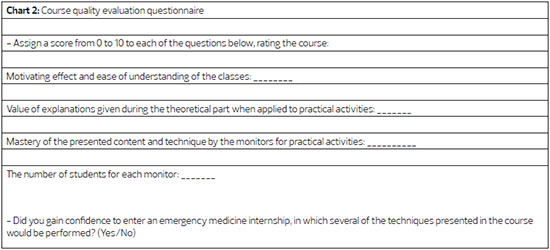
 Read in Portuguese
Read in Portuguese
 Read in English
Read in English
 PDF PT
PDF PT
 Print
Print
 Send this article by email
Send this article by email
 How to Cite
How to Cite
 Mendeley
Mendeley
 Pocket
Pocket
 Twitter
Twitter